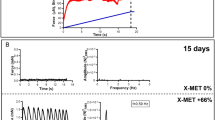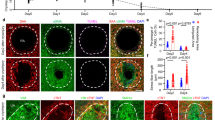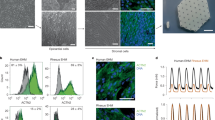Abstract
The concept of regenerating diseased myocardium by implantation of tissue-engineered heart muscle is intriguing, but convincing evidence is lacking that heart tissues can be generated at a size and with contractile properties that would lend considerable support to failing hearts. Here we created large (thickness/diameter, 1–4 mm/15 mm), force-generating engineered heart tissue from neonatal rat heart cells. Engineered heart tissue formed thick cardiac muscle layers when implanted on myocardial infarcts in immune-suppressed rats. When evaluated 28 d later, engineered heart tissue showed undelayed electrical coupling to the native myocardium without evidence of arrhythmia induction. Moreover, engineered heart tissue prevented further dilation, induced systolic wall thickening of infarcted myocardial segments and improved fractional area shortening of infarcted hearts compared to controls (sham operation and noncontractile constructs). Thus, our study provides evidence that large contractile cardiac tissue grafts can be constructed in vitro, can survive after implantation and can support contractile function of infarcted hearts.
This is a preview of subscription content, access via your institution
Access options
Subscribe to this journal
Receive 12 print issues and online access
$209.00 per year
only $17.42 per issue
Buy this article
- Purchase on SpringerLink
- Instant access to full article PDF
Prices may be subject to local taxes which are calculated during checkout





Similar content being viewed by others
References
Murry, C.E., Field, L.J. & Menasche, P. Cell-based cardiac repair: reflections at the 10-year point. Circulation 112, 3174–3183 (2005).
Eschenhagen, T. & Zimmermann, W.H. Engineering myocardial tissue. Circ. Res. 97, 1220–1231 (2005).
Reinecke, H., Zhang, M., Bartosek, T. & Murry, C.E. Survival, integration, and differentiation of cardiomyocyte grafts: a study in normal and injured rat hearts. Circulation 100, 193–202 (1999).
Condorelli, G. et al. Cardiomyocytes induce endothelial cells to trans-differentiate into cardiac muscle: implications for myocardium regeneration. Proc. Natl. Acad. Sci. USA 98, 10733–10738 (2001).
Muller-Ehmsen, J. et al. Rebuilding a damaged heart: long-term survival of transplanted neonatal rat cardiomyocytes after myocardial infarction and effect on cardiac function. Circulation 105, 1720–1726 (2002).
Li, R.K. et al. Natural history of fetal rat cardiomyocytes transplanted into adult rat myocardial scar tissue. Circulation 96 Suppl., II-179–86; discussion 186–7 (1997).
Taylor, D.A. et al. Regenerating functional myocardium: improved performance after skeletal myoblast transplantation. Nat. Med. 4, 929–933 (1998).
Soonpaa, M.H., Koh, G.Y., Klug, M.G. & Field, L.J. Formation of nascent intercalated disks between grafted fetal cardiomyocytes and host myocardium. Science 264, 98–101 (1994).
Assmus, B. et al. Transplantation of Progenitor Cells and Regeneration Enhancement in Acute Myocardial Infarction (TOPCARE-AMI). Circulation 106, 3009–3017 (2002).
Orlic, D. et al. Bone marrow cells regenerate infarcted myocardium. Nature 410, 701–705 (2001).
Stamm, C. et al. Autologous bone-marrow stem-cell transplantation for myocardial regeneration. Lancet 361, 45–46 (2003).
Strauer, B.E. et al. Repair of infarcted myocardium by autologous intracoronary mononuclear bone marrow cell transplantation in humans. Circulation 106, 1913–1918 (2002).
Beltrami, A.P. et al. Adult cardiac stem cells are multipotent and support myocardial regeneration. Cell 114, 763–776 (2003).
Oh, H. et al. Cardiac progenitor cells from adult myocardium: homing, differentiation, and fusion after infarction. Proc. Natl. Acad. Sci. USA 100, 12313–12318 (2003).
Balsam, L.B. et al. Haematopoietic stem cells adopt mature haematopoietic fates in ischaemic myocardium. Nature 428, 668–673 (2004).
Murry, C.E. et al. Haematopoietic stem cells do not transdifferentiate into cardiac myocytes in myocardial infarcts. Nature 428, 664–668 (2004).
Nygren, J.M. et al. Bone marrow-derived hematopoietic cells generate cardiomyocytes at a low frequency through cell fusion, but not transdifferentiation. Nat. Med. 10, 494–501 (2004).
Kehat, I. et al. Human embryonic stem cells can differentiate into myocytes with structural and functional properties of cardiomyocytes. J. Clin. Invest. 108, 407–414 (2001).
Laugwitz, K.L. et al. Postnatal isl1+ cardioblasts enter fully differentiated cardiomyocyte lineages. Nature 433, 647–653 (2005).
Messina, E. et al. Isolation and expansion of adult cardiac stem cells from human and murine heart. Circ. Res. 95, 911–921 (2004).
Eschenhagen, T. et al. Three-dimensional reconstitution of embryonic cardiomyocytes in a collagen matrix: a new heart muscle model system. FASEB J. 11, 683–694 (1997).
Zimmermann, W.H. et al. Three-dimensional engineered heart tissue from neonatal rat cardiac myocytes. Biotechnol. Bioeng. 68, 106–114 (2000).
Zimmermann, W.H. et al. Tissue engineering of a differentiated cardiac muscle construct. Circ. Res. 90, 223–230 (2002).
Carrier, R.L. et al. Cardiac tissue engineering: cell seeding, cultivation parameters, and tissue construct characterization. Biotechnol. Bioeng. 64, 580–589 (1999).
Leor, J. et al. Bioengineered cardiac grafts: A new approach to repair the infarcted myocardium? Circulation 102 Suppl. 3, III56–III61 (2000).
Li, R.K. et al. Survival and function of bioengineered cardiac grafts. Circulation 100 Suppl., II63–II69 (1999).
Zimmermann, W.H. et al. Cardiac grafting of engineered heart tissue in syngenic rats. Circulation 106, I151–I157 (2002).
Dhein, S., Muller, A., Gerwin, R. & Klaus, W. Comparative study on the proarrhythmic effects of some antiarrhythmic agents. Circulation 87, 617–630 (1993).
Menasche, P. et al. Autologous skeletal myoblast transplantation for severe postinfarction left ventricular dysfunction. J. Am. Coll. Cardiol. 41, 1078–1083 (2003).
Jackson, K.A. et al. Regeneration of ischemic cardiac muscle and vascular endothelium by adult stem cells. J. Clin. Invest. 107, 1395–1402 (2001).
Acknowledgements
This work is part of the doctoral thesis of I.M. at the Universities of Erlangen-Nuremberg and Hamburg. We acknowledge the technical assistance of S. John and F. Bussmann (University of Erlangen; MRI data evaluation) and T. Müller (University of Erlangen; construction of stretch devices). The help from H. Rütten and D. Gehling (Aventis, Frankfurt) in echocardiography and pressure-volume loop recordings is appreciated. This study was supported by the German Research Foundation (Deutsche Forschungsgemeinschaft; Es 88/8-2 to T.E. and FOR 604/1-1 to T.E. and H.E.), the German Ministry for Education and Research (Bundesministerium für Bildung und Forschung 01GN 0124 and BMBF 01GN 0520 to T.E. and W.-H.Z.), the Deutsche Stiftung für Herzforschung (W.-H.Z.) and the Minerva foundation (W.-H.Z.).
Author information
Authors and Affiliations
Corresponding authors
Ethics declarations
Competing interests
The authors declare no competing financial interests.
Supplementary information
Supplementary Fig. 1
Relating functional effects of optimized EHTs to molecular alterations in EHTs. (PDF 115 kb)
Supplementary Fig. 2
Cell composition of multi-unit EHTs. (PDF 114 kb)
Supplementary Fig. 3
Echocardiography assessment. (PDF 398 kb)
Supplementary Fig. 4
DAPI labeling of EHT grafts. (PDF 17896 kb)
Supplementary Fig. 5
Ambulatory echocardiogram telemetry. (PDF 101 kb)
Supplementary Table 1
Summary of the experimental outline. (PDF 23 kb)
Supplementary Table 2
Echocardiography data. (PDF 267 kb)
Supplementary Table 3
MRI data. (PDF 115 kb)
Supplementary Table 4
Catheterization data. (PDF 151 kb)
Supplementary Video 1
Multiunit engineered heart tissue. (MOV 6008 kb)
Rights and permissions
About this article
Cite this article
Zimmermann, WH., Melnychenko, I., Wasmeier, G. et al. Engineered heart tissue grafts improve systolic and diastolic function in infarcted rat hearts. Nat Med 12, 452–458 (2006). https://doi.org/10.1038/nm1394
Received:
Accepted:
Published:
Issue Date:
DOI: https://doi.org/10.1038/nm1394



